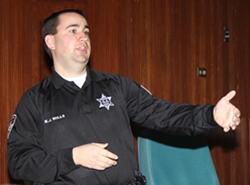
| CONNECTIONS |
IDAHO
ITD
HOME
511 TRAVEL SERVICES
IDAHO
DMV
ITD
NEWS
HIGHWAY
SAFETY
IDAHO STATE POLICE
STATE OF IDAHO
NIATT
NATIONAL
AASHTO
AAMVA
AAA of IDAHO
FEDERAL HIGHWAYS
FEDERAL AVIATION
IDAHO STATE POLICE
NHTSA
NTSB
TRB
U.S. DOT
TRANSPORTER
Archives
Milestones
Comments
Idaho
Transportation
Department
Office of Communications
P.O. Box 7129
Boise, ID 83707
208.334.8005
Fax: 208.334.8563

Police officers share safe driving tips
with ITD employees at Headquarters
Kyle Wills and Ken Beckner know too well the impact winter weather can have on driving safely. They see the results on a daily basis – Wills from the seat of a Boise City Police motorcycle and Beckner from behind the wheel of a state police cruiser.
 The law enforcement officers brought their message of safe winter driving to ITD Headquarters Wednesday where about 50 employees turned out for a presentation sponsored by the Headquarters’ Safety Committee.
The law enforcement officers brought their message of safe winter driving to ITD Headquarters Wednesday where about 50 employees turned out for a presentation sponsored by the Headquarters’ Safety Committee.
Their observations along with training and experience helped frame a variety of safe driving suggestions and added to nearly 30 minutes of dialogue with ITD employees.
Driving is the most dangerous activity most adults do on a daily basis, Wills explained. Every year about 40,000 people are killed on America’s highways.
Following are some of their recommendations for driving safely in hazardous winter conditions.
-
Make a habit of buckling your seat belt as soon as you get into a vehicle. Do it often enough and it will become second nature.
-
Build additional time into your trip in the winter and plan ahead for bad driving conditions. Anticipate. Prepare for worst-case scenarios.
-
Guard against distractions. If something can wait until after you reach your destination, let it wait. Focus all of your attention on the complex task of driving.
-
Maintain a safe distance between your vehicle and the one you’re following. In good driving conditions you should remain about three seconds behind – more if highway conditions warrant. That translates to about 95-100 feet on an interstate at 65 mph.
-
Adjust your driving habits to highway and weather conditions. The posted speed limit is a maximum for ideal conditions. Poor weather and slick roads likely will require speeds slower than the posted limit. Speeding citations can, and are, issued for driving too fast for the prevailing conditions, even if you’re traveling less than the posted limit. The basic rule is to drive according to the conditions.
-
Check your vehicle before driving. Make a cursory inspection by walking around your vehicle before getting in. Clear snow and ice from windshields, wiper blades, headlights and tail lights before driving.
-
Inspect your vehicle for mechanical problems before bad weather arrives.
-
Carry winter provisions in your vehicle, such as: tire and tow chains, blanket, drinking water, nutritious snacks, sand or cat litter for traction, flashlight… See a previous Transporter article for a more comprehensive list.
-
Guard against over-confidence when driving four-wheel drive vehicles. They provide better traction while starting to drive, but are no better at stopping on slick highways than a two-wheel or front-wheel vehicle.
-
High-profile vehicles, vans and sport utility vehicles, are more susceptible to rollovers than vehicles with a lower center of gravity. Extra caution is needed when driving SUVs, even those that have four-wheel or all-wheel drive trains.
-
Drive as slowly as possible in extreme fog to allow time for stopping. Your speed multiplied by 1.5 is the distance in feet that you travel in a second. 30 mph multiplied by 1.5 equals 45 feet in one second.
-
Even if a highway surface doesn’t appear to be slick, it can be. Black ice is a hidden threat that can have tragic consequences. Even if the ambient air temperature is slightly above freezing, the highway surface can be below freezing, causing slick conditions. Be especially careful on bridges and overpasses where highways are cooled from above and beneath.
-
Watch for icy patches in shaded areas of the highway that don’t get much direct sunlight. They can be very slick even when the roadway on both sides is bare and dry.
-
Slow down before entering a curve or corner, not after you’re already in one.
-
Allow extra time to reach your destination in the winter. Let friends and families know your itinerary and anticipated route, then call when you arrive safely.
-
Anticipate. Expect and prepare for bad highway and weather conditions. Check 511 on the Web (511.idaho.gov) or call 511 before leaving home during inclement weather.
Dialogue following the formal presentation touched on such subjects as aggressive driving/road rage, what to do when in involved in a crash or when arriving at the scene of a crash, reporting unsafe driving behavior, extrication from a crashed vehicle, and adding emergency contact information to cellular phone lists.
Published 12-19-8